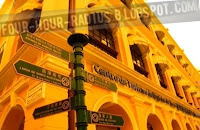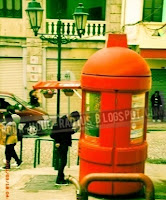

"Bus number 3 daw," TC tells you, referring to which one to take going to Largo de Senado.
An hour after leaving the former British colony of Hong Kong not on a jetplane, but on a jetfoil, you and TC, your favorite travel companion, find yourself in another Eurasian territory - Portuguese buildings, Chinese signs, rickshaws, Cantonese spoken everywhere, the combined smell of egg tart, Portuguese food, and dimsum - You silently welcome yourself to Macau.
 TC hops on the bus and takes the seat behind the driver. They drive on the right here and you and TC still get confused as to where to look when crossing the street.
TC hops on the bus and takes the seat behind the driver. They drive on the right here and you and TC still get confused as to where to look when crossing the street.It was late afternoon and a swarm of local Macanese office workers and students fill your bus up. Half an hour later, you see the cobblestones and the yellow European buildings.

"This is it," you tell TC while putting your bag around your shoulder.
A silent protest to your right, dark clouds, and hundreds of tourists - you are in Largo de Senado or Senado Square, probably the most popular bus stop in this tiny colony.

TC is hungry, and so are you. On your hunt for authentic Macanese cuisine, you settle for a restaurant in the middle of the square - Macau Recipes. It seemed a little dark inside, with servers surprised at your arrival and a little hesitant to work this time of day. Maybe it was their siesta time. The waitress hands you the menu and you instantly choose pork chops with some Portuguese sauce. Macanese cuisine is a fusion of Cantonese ingredients and Portuguese cooking. The food arrives at your table and after five minutes, you're done, and you are off to your next stop - Rua de Sao Paolo.
 You thought Macau was less densely populated than Hong Kong. You may be right. But it probably is the end of a school day, as little kids in school uniforms are all around. You wonder where they are headed as this is a tourist area. Maybe they live in apartments behind the shops you pass, selling kites, postcards, and all those usual Macanese trinkets you wouldn't have use for, like keychains, which your friends keep giving you on every trip. You stop by one shop though, to pick up some postcards for your collection.
You thought Macau was less densely populated than Hong Kong. You may be right. But it probably is the end of a school day, as little kids in school uniforms are all around. You wonder where they are headed as this is a tourist area. Maybe they live in apartments behind the shops you pass, selling kites, postcards, and all those usual Macanese trinkets you wouldn't have use for, like keychains, which your friends keep giving you on every trip. You stop by one shop though, to pick up some postcards for your collection.
 Alas, after navigating the hilly, cobblestoned roads, you get to Rua. Rua de Sao Paolo is what is left of an old church. The government restored its facade, making it the most popular landmark in Macau. TC whips out his camera, as usual, and asks you if you wanted a photo. You are so over that tourist-y pose of having all these tourist spots behind you on your pictures.
Alas, after navigating the hilly, cobblestoned roads, you get to Rua. Rua de Sao Paolo is what is left of an old church. The government restored its facade, making it the most popular landmark in Macau. TC whips out his camera, as usual, and asks you if you wanted a photo. You are so over that tourist-y pose of having all these tourist spots behind you on your pictures.  "I think that's a post office," you tell TC, pointing to a red kiosk beside the stairs leading to Rua. You ask him to snap a shot of you mailing a postcard to your aunt in California, which has been a habit every time you travel.
"I think that's a post office," you tell TC, pointing to a red kiosk beside the stairs leading to Rua. You ask him to snap a shot of you mailing a postcard to your aunt in California, which has been a habit every time you travel.You pay the post woman in pataca, Macau's currency which has almost the same value as the HKD. You thank her and navigate the stairs leading to Rua's facade.
 You look up. You marvel at the ruins of a church that was built more than 400 years ago. It was less than 15 degrees Celsius and the wind that is blowing is even colder. This is Rua de Sau Paolo, probably Macau's most popular landmark. It's not exactly off the beaten path, but for some reason, you are at peace here. Noisy, busy, overpopulated Hong Kong is just 40 miles away, but these two places are worlds apart. You haven't really stayed here for more than a day, but you promise yourself to be back really, really soon. ●
You look up. You marvel at the ruins of a church that was built more than 400 years ago. It was less than 15 degrees Celsius and the wind that is blowing is even colder. This is Rua de Sau Paolo, probably Macau's most popular landmark. It's not exactly off the beaten path, but for some reason, you are at peace here. Noisy, busy, overpopulated Hong Kong is just 40 miles away, but these two places are worlds apart. You haven't really stayed here for more than a day, but you promise yourself to be back really, really soon. ●
No comments:
Post a Comment